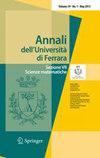作为素环上交换映射的广义偏导
Q2 Mathematics
引用次数: 0
摘要
假设R是一个带char \((R)\ne 2\)的非交换素环。假设\(\kappa \left( x_{1}, \ldots , x_{n}\right) \)是C (\(S=\{\kappa (\wp _1,\ldots ,\wp _n) \mid \wp _1,\ldots ,\wp _n \in R\}\))上的非中心多元线性多项式。如果F, G和H是R上与相同自同构\(\beta \)相关的三个广义偏导,使得$$ H\left( \xi \right) \xi -F(\xi )G(\xi )=0 $$对于每个\(\xi \in S\)。设\(g_1,g_2,g_3 \)分别为H、F和G的相关偏导数,使得\(g_1,g_2,g_3\)与\(\beta \)可交换。然后给出H, F, G的结构。本文章由计算机程序翻译,如有差异,请以英文原文为准。
Generalized skew-derivations acting as commuting maps on prime rings
Suppose R is a non-commutative prime ring with char\((R)\ne 2\). Suppose that \(\kappa \left( x_{1}, \ldots , x_{n}\right) \) is a noncentral multilinear polynomial over C, \(S=\{\kappa (\wp _1,\ldots ,\wp _n) \mid \wp _1,\ldots ,\wp _n \in R\}\). If F, G and H are three generalized skew-derivations on R associated to the same automorphism \(\beta \) such that
$$ H\left( \xi \right) \xi -F(\xi )G(\xi )=0 $$
for each \(\xi \in S\). Let \(g_1,g_2,g_3 \) be the associated skew derivations respectively of H, F and G, such that \(g_1,g_2,g_3\) are commuting with \(\beta \). Then we shall give the structure of H, F and G.
求助全文
通过发布文献求助,成功后即可免费获取论文全文。
去求助
来源期刊

Annali dell''Universita di Ferrara
Mathematics-Mathematics (all)
CiteScore
1.70
自引率
0.00%
发文量
71
期刊介绍:
Annali dell''Università di Ferrara is a general mathematical journal publishing high quality papers in all aspects of pure and applied mathematics. After a quick preliminary examination, potentially acceptable contributions will be judged by appropriate international referees. Original research papers are preferred, but well-written surveys on important subjects are also welcome.
 求助内容:
求助内容: 应助结果提醒方式:
应助结果提醒方式:


